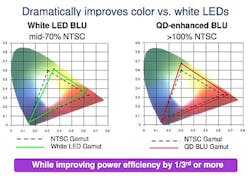
Quantum dots are now lighting up televisions with fuller, richer colors than flat-panel screens could previously deliver. They debuted in mid-May as "Triluminos technology" on Sony's high-end sets, including a 55 in. model with 2160-line, ultra-HD resolution that will set you back $5,000. It's the first consumer application for a long-promising technology.
The appeal of quantum dots is that they emit purer colors than conventional LCD backlights, allowing the screens to display a broader gamut of colors than with conventional backlights. Fluorescent backlights use phosphors to generate red, green, and blue; LEDs use phosphors to generate red and green when illuminated by a blue LED. Phosphor bands typically span about 90 nm, but quantum dots have a narrower linewidth that depends on their size.
Producing narrow-band emission from large numbers of quantum dots requires exceptional control over their sizes, but QD Vision (Lexington, MA) has developed a process that limits size variations to <0.1 nm, reducing the emission bands to 30 nm for red and green quantum dots illuminated by blue LEDs. The resulting pure colors can be blended to cover a larger range of colors than required by the NTSC color standard, as shown in the figure. The less-pure colors from phosphors limit the range of achievable colors to about two-thirds of that range. As a result, the quantum-dot backlit screens can display a richer range of colors.QD Vision builds its quantum dots into rods that Sony places next to blue LEDs for backlighting of its edge-illuminated displays. Nanosys (Palo Alto, CA) and 3M (St. Paul, MN) are now producing their own version of the technology—a Quantum Dot Enhancement Film (QDEF) in the form of sheets placed between backlights and LCD screens, which it announced at the Society for Information Display's DisplayWeek show May 21-23 in Vancouver.
Both are aiming quantum dots at the large-screen market. Organic LEDs also offer a large color gamut and have been touted for the next generation of large-screen displays, but scaling to large sizes has proved difficult. So far, reviewers and analysts say quantum dots look good. "The TVs shown in the QD Vision booth were very impressive, as they significantly increase color space and now rivals that achievable with AMOLED," wrote analyst Norbert Hildebrand at Display Central.
About the Author
Jeff Hecht
Contributing Editor
Jeff Hecht is a regular contributing editor to Laser Focus World and has been covering the laser industry for 35 years. A prolific book author, Jeff's published works include “Understanding Fiber Optics,” “Understanding Lasers,” “The Laser Guidebook,” and “Beam Weapons: The Next Arms Race.” He also has written books on the histories of lasers and fiber optics, including “City of Light: The Story of Fiber Optics,” and “Beam: The Race to Make the Laser.” Find out more at jeffhecht.com.

